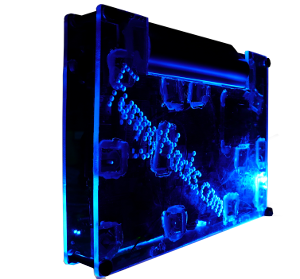
Hook every audio source to every audio output in an easily switchable way.
Choosing whether to hook things up in series or parallel affects the impedance of the circut. This is relevant to you, because this is how you blow things slowly. Think of it like driving to your destination in 1st gear. The car will do it, but the engine won't be thanking you for it. The same thing is true for audio, if the resistance of the circut falls too low, things go bad.
To know what to aim for, you need to know what your device that produces the signal is expecting. Typically, car audio is 4 Ohms and Home audio is 8 Ohms. But there are plenty of exceptions, so please check! :) If the resistance is too low, you'll be in trouble... but not necessarily straight away. While if it's too quiet, I believe the only side affect is a volume output. As a general rule of thumb, try to get the speakers as close to the rating that the amplifier is expecting.
Right, so with this said, how does series vs parallel wiring affect this?
Wiring load in series increases the resistance... Good thing, but inconvenient.
Wiring load in parallel decreases resistance... Be careful doing this, but it is very convenient. And this is how the circut diagram I've put here works. This is one very good reason for using 3 state switches as described below.
While I know enough to keep myself out of trouble most of the time, this is an area that I have yet to need to know more. If you would like to know more, you may like to read:
Black represents the common line, or the central line as I referred to it in the video. Red and blue represent the two channels.
Volume/input leveles - too high can cause things to blow.
One of the things I would do differently if I was to do this again is to use 3 state switches instead of 2 state switches. This would allow devices to have an "Off" state as well as A and B channels. Or if you prefer, a third channel.